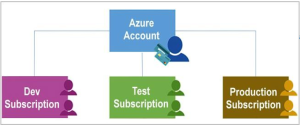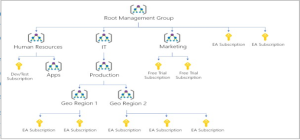Subscriptions & Management groups
Subscriptions
- Using Azure requires an Azure subscription.
- An Azure subscription is a logical unit of Azure services that links to an Azure account. It also allows you to provision resources.
- A subscription provides you with authenticated and authorized access to Azure products and services.
- Azure generates separate billing reports and invoices for each subscription
- Two types of subscription boundaries
- Billing boundary
- Access control boundary
- You can create separate subscriptions based on:
- Environment: development and testing, security, or isolating data for compliance reasons
- Organizational structures: IT, HR, Admin, and so on
- Billing: manage and track costs based on your needs, for example, Production, Test, and Dev.

Different types of Subscription:
- FREE: An email address and a credit card are required to sign up for a free trial subscription that provides $200 credit for the first 30 days and 12 months of restricted access.
- Pay-Per-Use: Charges monthly based on Cloud resource use.
- Enterprise: A single Enterprise agreement is established for large subscription purchases, including savings for new licenses and Software Assurance.
- Student: This membership includes $100 for 12 months and may be activated without a credit card.
Management groups
- Management groups let you organize multiple subscriptions as a single management entity to facilitate easier management.
- You can create management groups in a hierarchical structure with the top level of the hierarchy at the tenant level and containing all subscriptions in that tenant.
- Any conditions applied to a management group apply to all subscriptions contained in that management group object.
- Each management group and subscription can support only one parent.
- Each management group can have many children.
- The root management group can’t be moved or deleted, unlike other management groups.

0
0






